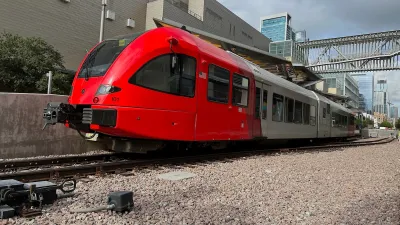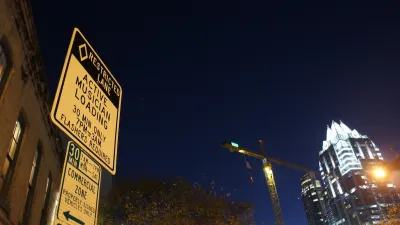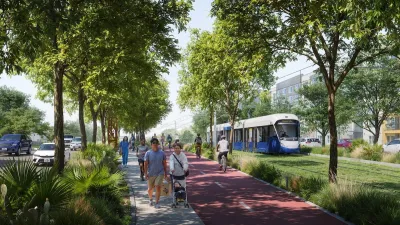Austin is pushing its economic development policy to go beyond chasing the big deal.
According to Andy Borowitz, the city of Austin needs help. “In a deepening humanitarian crisis, residents of the city of Austin report that they are completely surrounded by Texas, a situation that locals are calling ‘dire,’” he wrote in The New Yorker, riffing on Austin’s reputation as a “laid-back” hub for alternative music, film production, and technological innovation in an otherwise conservative state—a reputation that attracts an estimated one hundred new residents daily.
But perhaps the more significant way Austin is currently distinguishing itself from the rest of Texas, and indeed the rest of the country, is its economic development policy.
Chapter 380—A Long Process
Austin is everywhere touted as an attractive place for businesses. It boasts a steadily growing population that is largely college-educated—an estimated 46.7 percent according to 2013 American Community Service data—and, perhaps most enticing to the private sector, it is centrally located in Texas, a state with anti-union laws that does not tax personal income.
But it has seen its share of business cycles. Austin’s current economic development policy can be traced back to 2003, in the wake of the dot-com implosion. Austin had just seen the end of a decade of extraordinary growth. Per capita income had increased from $18,092 in 1990 to $32,039 in 2000, and the average price of a home had skyrocketed from $87,600 in 1990 to $199,500 by 2003. A fast-growing population, the rapid expansion of businesses, and significant investment in technology-related industries and Internet start-ups had helped to bump Austin to the top of the Forbes Magazine-Milken Institute rankings of Best Places for Business and Career in 1999 through 2001.
The national recession after 2001 caused this growth to flatline. Austin’s unemployment rate hit 6.2 percent in January 2003, well above the national average of 5.8 percent. Median family income dropped 5.9 percent from $71,100 in 2002 to $66,900 in 2003.
In addition, the overall income growth of the previous decade belied economic and racial disparities that continued to widen even as the economy began to recover from the recession. With the “tech” economy came high-paying jobs inaccessible to people without a high school diploma or a background in information technology, putting so-called “low-skilled” workers at a distinct disadvantage. While median family income increased slightly for the city’s white and Asian populations between 2000 and 2007, Latino and African-American families saw a sharp drop in median income, from approximately $45,000 a year to just over $37,000. A report released three years later noted that between 2006 and 2010, median earnings in Austin increased by 7 percent for white households but only by 4.9 percent for African-American households; Latino households experienced a 4.3 percent drop in median income during the same period.
At the same time, an influx of residents earning a higher salary drove up the cost of living, making it harder for low-income workers to make ends meet. East Austin, traditionally home to a large African-American community and located close to downtown, was a target for gentrification, which drove up housing prices and pushed out long time African-American residents in a trend that has yet to reverse itself.
FULL STORY: In Austin, Corporations Don't Get Paid for Promises

Alabama: Trump Terminates Settlements for Black Communities Harmed By Raw Sewage
Trump deemed the landmark civil rights agreement “illegal DEI and environmental justice policy.”

Study: Maui’s Plan to Convert Vacation Rentals to Long-Term Housing Could Cause Nearly $1 Billion Economic Loss
The plan would reduce visitor accommodation by 25% resulting in 1,900 jobs lost.

Why Should We Subsidize Public Transportation?
Many public transit agencies face financial stress due to rising costs, declining fare revenue, and declining subsidies. Transit advocates must provide a strong business case for increasing public transit funding.

Paris Bike Boom Leads to Steep Drop in Air Pollution
The French city’s air quality has improved dramatically in the past 20 years, coinciding with a growth in cycling.

Why Housing Costs More to Build in California Than in Texas
Hard costs like labor and materials combined with ‘soft’ costs such as permitting make building in the San Francisco Bay Area almost three times as costly as in Texas cities.

San Diego County Sees a Rise in Urban Coyotes
San Diego County experiences a rise in urban coyotes, as sightings become prevalent throughout its urban neighbourhoods and surrounding areas.
Urban Design for Planners 1: Software Tools
This six-course series explores essential urban design concepts using open source software and equips planners with the tools they need to participate fully in the urban design process.
Planning for Universal Design
Learn the tools for implementing Universal Design in planning regulations.
Smith Gee Studio
Alamo Area Metropolitan Planning Organization
City of Santa Clarita
Institute for Housing and Urban Development Studies (IHS)
City of Grandview
Harvard GSD Executive Education
Toledo-Lucas County Plan Commissions
Salt Lake City
NYU Wagner Graduate School of Public Service





























